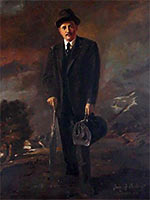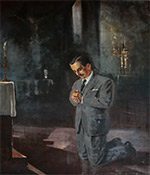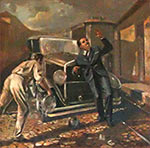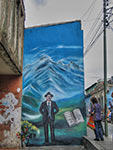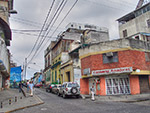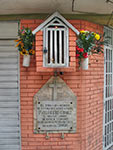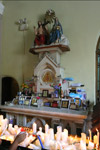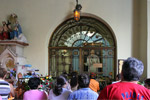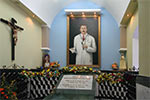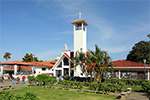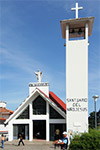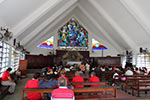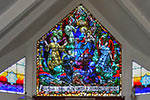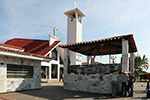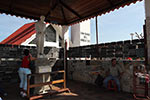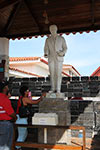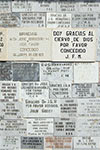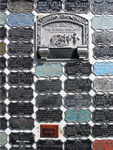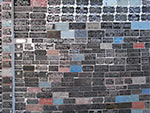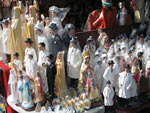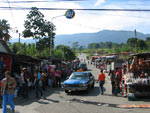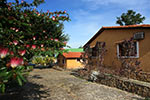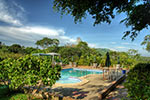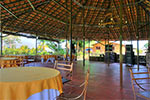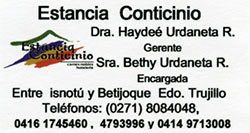|
Jose Gregorio Hernandez - future Saint of Venezuela
Tiwy.com team
December 2006
Doctor Jose Gregorio Hernandez can be called the most well known Venezuelan of all the times. He was glorified owing to his whole-hearted service to the people, whom he had never refused to help – neither in treatment, nor in scientific knowledge and comforting word of blessing.
His course of life of a doctor, scientist, religious figure came beyond the framework of time. Curious student and a young scientist of the 19th century, unselfish doctor and wise academician of medicine of the 20th century and - as expected – the Saint of Venezuela in the 21st century.
People believe that after his premature death in 1919 when he was only 56, it was only due to his invisible help many miraculous healings of the sick occurred, and as a rule, of people from the poorest families. Peoples rumors call Jose Gregorio – a «doctor of the poor».
Jose Gregorio Hernandez was born on October 26, 1864 in a quiet town of Isnotu, that is lost at the foothills of the Venezuelan Andes. His parents, Benigno Hernandez Manzaneda and Josefa Antonia Cisneros, kept a small store, where one could buy everything that may be needed in the everyday life of the godforsaken province – starting from the food-staff to clothes and perfumes. His father, however, besides trading, was keen on medicine, especially herbal medicine. And the local people would willingly go to him – he would diagnose the disease and prepare the needed medicament.
Jose Gregorio might have inherited these inclinations of the healer from his father. He got medical education in the Central university of Venezuela - the best educational establishment of the country. Then he went to Europe, to Paris to get new knowledge and obtained the academic intricacies at the famous Pasteur institute. It is not by chance that later he was called a «Venezuelan Pasteur»: it was he, who gave an impetus to development of the medical science in Venezuela, first of all in such little-studied at that time field of microbacteriology.
The contemporary Venezuelans valued Jose Gregorio Hernandez not only for his contribution to medicine that started to flourish in his times, but most of all for his benevolence, sincerity and openness of his soul. He rushed to help at the first call and never asked any questions whether his services of the doctor would be paid for or not. He never differentiated between rich or poor patients, but he was more often seen in the poor peasants' quarters.
The «doctor of the poor» life was linked with catholic church by the most tight bonds. Hernandez was a very pious person, and to such an extent, that twice during his stay in Europe he tried to become a monk in the monasteries with very severe regulations. But weak health did not allow the dream of Jose Gregorio to come true. The fate might have demanded a different thing from him – everyday sacrificial heroism in the whole-hearted service to the people.
The life of Jose Gregorio came to an abrupt end. It is here, on June 29, 1919, at the cross-roads in La Pastora, colonial district of Caracas, the «doctor of the poor» was run down by a car. That Sunday morning Jose Gregorio after the morning mass in La Pastora church hurried to the patient and on his way dropped at the drug store to buy a medicine for her. Jose Gregorio came out of the drug store and started to walk around the standing at the cross-roads tram. The doctor, deep in his thoughts, did not notice the approaching car. Vehicles at those years just started to appear in Caracas. According to the present standards they moved rather slowly – not more than 30-35 km per hour, and none the less, the absurd, unexpected, treacherous death seemed to be waiting for Jose Gregorio. Everything happened instantaneously: the car appeared as if from nowhere, Jose Gregorio was thrown away, lost his balance and falling down he struck his head against the stone curb of the pavement. That was how Venezuela has lost one of its best people.
That tragic news immediately spread around Caracas. Thousands of people came to see the adored person to his final journey. People carried his coffin on their shoulders – first to the Cathedral, then across the complete city to the Southern cemetery (Ñementerio General del Sur). People cried: «Our doctor has expired!», «Our Saint has gone!»
Decades have passed since that tragic event, and with every passing year the faith of the Venezuelans into holiness of Jose Gregorio Hernandez and his healing divine gift is getting stronger. The image of the «doctor of the poor» can be seen everywhere: on the self-made icons, posters, key-chains and amulets, calendars and stamps. Probably there does not exist a single house in Venezuela that does not have an outwardly modest statue of a man in a black suit and hat. Very many people give their children a name of Jose Gregorio during christening. This man is invariably appealed to with a prayer for help, when a misfortune comes into the house, and if it leaves – people do not spare the words of gratitude to his address. Jose Gregorio has never refused those who suffer!
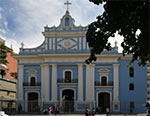 |
After the fire on the grave of the «peoples doctor» on October 23, 1975, caused by permanently lit memorial candles, his remains were shifted to the boundary of La Candelaria church in the center of Caracas. And for many years since, every day at 6 pm there is a mass in the church dedicated to Jose Gregorio Hernandez. Parishioners looking at his image, pray for health for themselves and their relatives, for good jobs, for family happiness...
In 1949, following the persistent requests of the believers, the hierarches of the catholic church of Venezuela started the process of beatification and canonization of Jose Gregorio Hernandez. All the following years featured collection of proofs of the «doctor of the poor» miracle-workings, unexpected healings that occurred after prayer requests to him. To the joy of all, who worship Jose Gregorio on January 16, 1986 Pope John Paul II (Juan Pablo II) issued a Decree on virtues of the Servant of God.
For final canonization of Hernandez, according to the existing rules of the Church, one more divine miracle is lacking. But for thousands of common Venezuelans Jose Gregorio has been a Saint for a long time. Aren't the last ten years of his short life, they say, a proof of his holiness? At that time disastrous epidemics one after another fell on Caracas. It was a Spanish influenza that especially raged – the flu that carried away millions of lives throughout the world. In those hard for citizens of Caracas days Jose Gregorio, as though under the divine protection, without fear of becoming infected, used to go from one house to another giving adequate help to those sick. And the disease avoided him. And in those times the sanitary culture was at a very low level. Weren't dozens of saved by him lives a miracle?
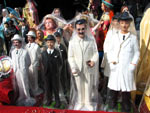 |
For some time now the Venezuelans started to notice certain changes in the traditional image of the savior: more and more often the black suit on the pictures and statues was replaced by a white gown. Kind of an unimportant detail. But that was done at the demand of Vatican: white clothes are more in line with church regulations and correspond to the image of the future Saint.
Every evening in the church at the Candelaria square the parishioners say one and the same prayer: «We beg for quick beatification of doctor Jose Gregorio Hernandez».
The glory of a miraculous healer crossed the borders of Venezuela long time ago, the name of Jose Gregorio Hernandez is honoured in many Latin American countries.
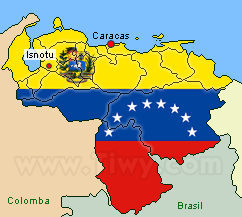 |
The town of Isnotu, birthplace of the miraculous doctor, was declared by the Venezuelan authorities a «Spiritual Place of Venezuela». Daily thousands of people come there to visit the Santuario – the Sanctuary, built in honor of the Servant of God Jose Gregorio Hernandez just to thank him for miraculous healings and support in difficult living situations.
|
The Sanctuary – is rather modest and plain: a temple, museum and administrative building are situated on a small territory. The place that attracts the visitors most of all is a rotunda with a sculpture of Jose Gregorio. It was that particular place where there used to be a house, in which Jose Gregorio was born and spent his childhood years. They go to the sculpture first of all, they say their endless prayers to it, they extend hands towards it in an attempt to touch the miracle. Parents raise their children and press them to the sculpture. What do they ask their Almighty Doctor for at those holy moments?
Stained-glass windows with the image of Jose Gregorio attract attention in a small temple.
There are few exhibits in a spacious museum: books out the doctor's library, remaining prescriptions made by his hand, his everyday life objects, letters sent to his sister and friends. Very expressive scenic paintings on the walls: artist Ivan Belsky depicted various episodes of Jose Gregorio life – doctor in the laboratory, at the University rostrum, among his friends and colleagues.
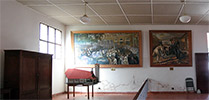 |
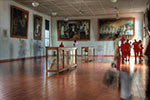 |
Most of all the Sanctuary strikes by an enormous number of placards, on which people express their gratitude to the doctor for his assistance in healing, in improving their personal life, in getting a well-paid job. There are at least 30 thousand of such placards. They cover walls of the buildings, rotunda, fence.
The streets that lead to the Sanctuary are filled with shops and boutiques, which sell everything that in this or that way connected with the miracle-working doctor: endless rows of white and black statues, key-chains, postcards and small flags. One may say that Isnotu obtained the second life owing to its compatriot. The financial and economic flourishing of the city directly depends on the influx of believers.
At the same time, those, who visited that town, note: there are few hotels, few various and reliable feeding points. We were lucky: we found a cosy rest house (a private hotel consisting of a number of separate small houses) «Estancia Conticinio» that may mean «A cosy rest». This rest house is situated at the outskirts of Isnotu on the road to Betijoque.
|
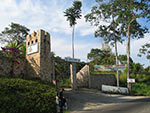 |
|


